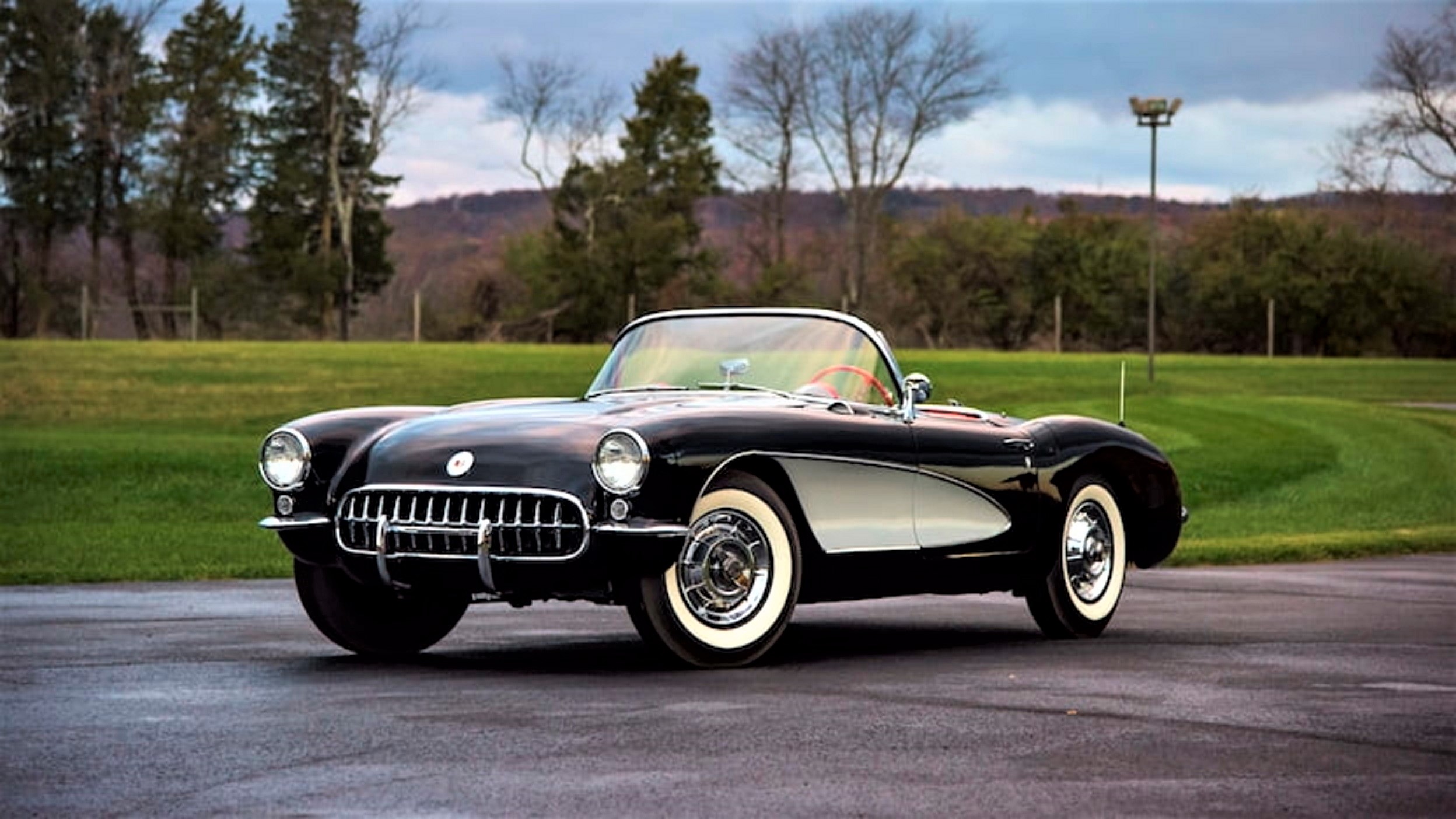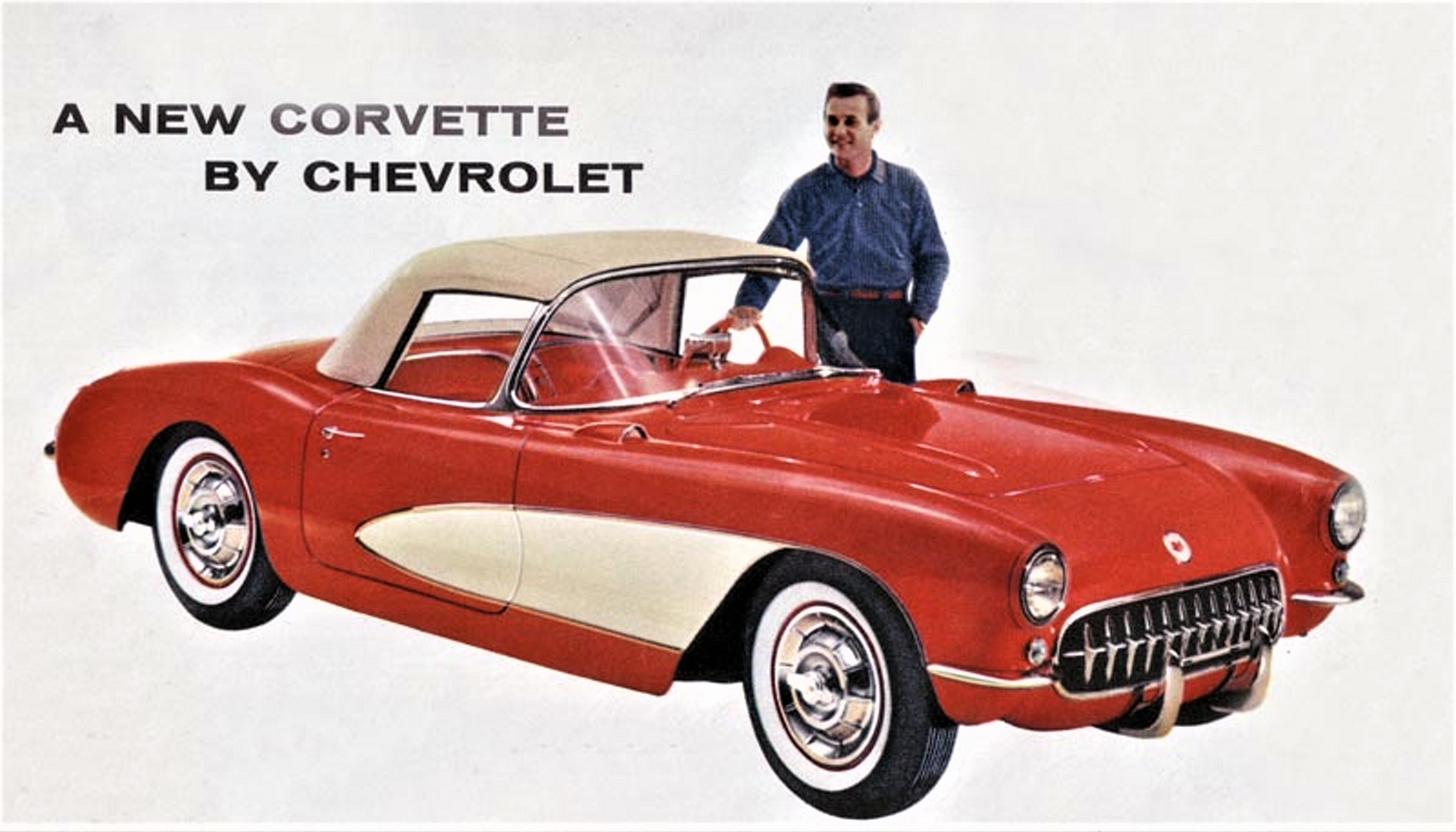 By 1956, the Corvette began to define itself as a true American sports car. A lot of people would have been perfectly content if Chevrolet had frozen Corvette styling with the 1956 model. The same basic grille styling was kept intact, but the grille teeth looked a bit slimmer.
By 1956, the Corvette began to define itself as a true American sports car. A lot of people would have been perfectly content if Chevrolet had frozen Corvette styling with the 1956 model. The same basic grille styling was kept intact, but the grille teeth looked a bit slimmer.
Chevrolet styling studio chief Clare MacKichan directed the 1956 redesign, which was somewhat inspired by the thrusting headlamps and twin-bulge hood of the Mercedes-Benz 300SL gullwing coupe. There were new front fenders with chrome-rimmed headlights; glass window; external door handles; chrome-outlined concave side body coves and sloping, taillight-integrated rear fenders.
Inside Corvettes, the dash layout remained the same. The 1956 rearview mirror was located on the center of the top of the dash and adjusted by using a thumbscrew. Improved-fit soft convertible tops were standard and a power top was optional, as was a removable fiberglass hardtop. Upholstery colors were limited to Beige or Red.
Nitro-cellulose lacquer finish was used and seven body colors were available. They were Onyx Black with a Silver panel (Black or White soft top); Polo White with a Silver panel (Black or White soft top); Venetian Red with a Beige panel (Beige or White soft top); Cascade Green with a Beige panel (Beige or White soft top); Aztec Copper with a Beige panel (Beige or White soft top); Arctic Blue with a Silver panel (Beige or White soft top) and Inca Silver with a Imperial Ivory panel (Black or White soft top).
 The Corvette used the standard Chevrolet Vehicle Identification Number (VIN) coding system. A tag was located on the left-hand front door hinge pillar and consisted of 10 symbols. The first symbol was an E for Corvette. The second and third symbols indicated the model year: 56=1956. The fourth symbol identified the assembly plant as follows: S=St. Louis, MO. The last six symbols were the sequential production number. The 1956 numbers started at E56S001001 and ended at E56S004467.
The Corvette used the standard Chevrolet Vehicle Identification Number (VIN) coding system. A tag was located on the left-hand front door hinge pillar and consisted of 10 symbols. The first symbol was an E for Corvette. The second and third symbols indicated the model year: 56=1956. The fourth symbol identified the assembly plant as follows: S=St. Louis, MO. The last six symbols were the sequential production number. The 1956 numbers started at E56S001001 and ended at E56S004467. All 1956 Corvettes were V-8 powered and all Chevrolet's with V-8 engines used a V serial number prefix. The beginning engine numbers were 0001001 and up at each assembly plant with F=Flint, MI and T=Tonawanda, NY. Suffixes were as follows: GV for 265-cid 210-hp V-8 with Powerglide: GU for 265-cid 240-hp V-8 with two four-barrel carburetors, high-lift "Duntov" camshaft and three-speed manual transmission; GR for regular 265-cid 225-hp V-8 with dual four-barrel and three-speed manual transmission; FK for 265-cid 210-hp V-8 with three-speed manual transmission and FG for 265-cid 225-hp V-8 with Powerglide.
The 1956 Corvette was offered only as an open car Model 2934. It was base priced at $2,900 and tipped the scale at 2,730 lbs. with stick shift and 75 lbs. additional with Powerglide automatic transmission. Production of 1956 Corvettes began Nov. 4, 1955 Chevy made 3,467 Corvettes during the model year.
Chevrolet general manager Ed Cole and Corvette chief engineer Zora Arkus-Duntov decided it was time for the Corvette to go racing in 1956. Zora drove one car to a two-way average of 150.583 mph at Daytona's Flying Mile. John Fitch also set a record of 90.932 mph for the standing-start mile at Daytona and 145.543 mph in the production sports car class.
In the spring of 1956, at Pebble Beach, CA dentist Dr. Dick Thompson finished second overall and first in class in a sports car road race. Thompson went on to take the Sports Car Club of America (SCCA) 1956 championship with his Corvette. A 225-hp 1956 Corvette could go from 0-to-60 mph in 7.3 seconds, from 0-to-100 mph in 20.7 seconds.